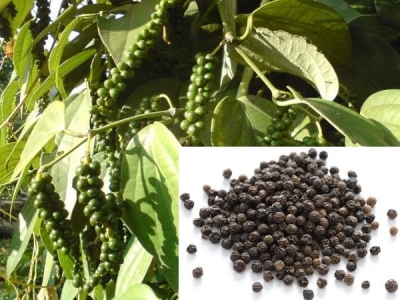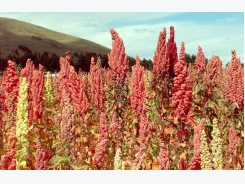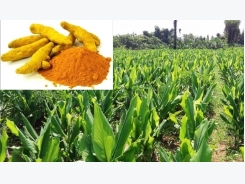Black Pepper Cultivation Information Guide

Introduction to Black Pepper Cultivation:- Black pepper is one of the popular spices known as ” king of spices”. Black pepper is a climbing evergreen plant (perennial climbing vine) and grows to a height of 30 feet and above. Black pepper is indigenous to south India (Western Ghats). Black pepper is being used as a spice and seasoning in most of the cuisines in the world. Basically black pepper is grown for its fruit, these fruits are dried to make ground pepper and used as a spice and seasoning. Once these fruits are dried, these are called as “peppercorn”. Black pepper is considered as a black gold in India as it contributes about 60 to 65% of total export earnings from all spices. Vietnam is top producer of black pepper in the world and Kerala is top production state in India which contributes 90% of black pepper production in the country. Apart from using as a spice, black pepper also used in traditional medicine since centuries.
Black Pepper Production stages include harvesting the unripe fruits (still in green stage) of the pepper vine and these fruits are boiled in hot water to clean the pepper fruits and make them ready for drying.
The pepper fruits are then dried in the sun for couple of days to make the pepper seed to shrink and darken into a thin, wrinkled black layer. At this stage, it is being called as “black peppercorn”. Pepper spirit and pepper oil is extracted from dried peppercorn through crushing process. These end products (pepper oil and pepper spirit) are being used in many Ayurvedic medicines, herbal treatments and beauty products. Commercial cultivation of black pepper is very much successful and one can obtain decent profits in growing black pepper with proper farm management practices.
Now let us talk in detail about black pepper cultivation in the following write-up.
Scientific Name / Botanical Name of Black Pepper:- Piper nigrum.
Family Name of Black Pepper:- Piperaceae.
Genus of Black Pepper Plant:- Piper.
Common Names of Black Pepper or Other Country Names:- Poivrier noir (French), Swart Peper (Afrikaans), Pebre (Catalan), zwarte peper (Dutch), Pfeffer / schwarzer Pfeffer (German), khar chinjüü (Mongolian), Piobar (Scottish), Pieprz czarny (Polish), Piper i zi (Albanian), crni biber (Bosnian), Pipar (Estonian), Máv̱ro Pipéri (Greek), piobar dubh (Irish), hu-cu (Korian), bżar iswed (Maltese), kālo maric (Nepali), pimenta-do-reino (Portuguese), Pimienta negra (Spanish), Filfil (Arabic), cheren piper (Bulgarian), 黑胡椒 / hēihújiā (Chinese), itim paminta (Filipino), pepe nero (Italian), prík tai dam (Thai), Pedes (Sundanese), Hồ tiêu (Vietnamese), Pghpegh (Armenian), Papar (Croatian), mustapippuri (Finnish), pilpel shachór (Hebrew), Kuro koshō (Japanese), Melnais pipars (Latvian), Piper negru (Romanian), Gammiris (Sinhalese), mrech khmaw (Cambodian), Pepř černý (Czech), crn píper (Macedonian), Перец чёрный (Russian), svartpeppar (Swedish), Karabiber (Turkish), Sort Peber (Danish), wùh jìu (Cantonese), shavi pilpili (Georgian), Fekete bors (Hungarian), Lada hitam (Malay), felfel-e siyâh (Persian), Marica (Sanskrit), 黑胡椒 (Taiwanese).
Black Pepper in Indian Languages:- Black Pepper (English), Kalimirchi / Kada Mari (Hindi), Kurumulagupodi (Tamil), Kurumulagupodi (Malayalam), Miriyaalu (Telugu), Menasina Kalu (Kannada), Goal Morich / Kala Morich (Bengali), Mari / Kadamari / Kalamari / Kalomirich / Golmirich (Gujarati), Miriyakonu / Mirsang / Miire / Mirin (Konkani), Mire / Kale Miri (Marathi), Golmarich (Oriya), Kalimirchi (Punjabi), Eddae Munchi (Tulu), Marutus (Kashmiri), Kali Mirch / Siah Mirch (Urdu), Jalook (Assamese), and Golmorok (Manipuri).
World Top 9 Production Countries of Black Pepper:- The following are the top nine production countries of Black Pepper.
- Vietnam
- India
- Brazil
- Indonesia
- Malaysia,
- Sri Lanka
- China
- Thailand
- Australia (Queensland)
Health Benefits and Uses of Black Pepper:- The following are some of the health benefits of Black Pepper.

Health Benefits of Black Pepper.
- Black Pepper is good remedy for cough and cold
- The antibacterial property of black pepper can prevent from infections
- Black pepper is good for dental health, gives good relief from tooth pain and prevents from tooth decay
- In Ayurvedic medicine, black pepper is used to prevent ear-aches and gangrene.
- The piperine in black pepper is helpful in certain type of cancer prevention
- Black pepper is good for digestion and prevents stomach disorders
- Black pepper is aids in weight loss management
- Black pepper is good for skin health
- Black pepper gives relief from depression
- Nutrition values in Black Pepper: The following chart is based on 100 grams of black pepper.
Serving Size: Black Pepper (whole peppercorns) 2 tsp (5.80 grams):
- GI (Glycemic index) – Very low
- Calories – 15
Nutrients:
- Manganese – 37%
- Vitamin K – 11%
- Copper – 9%
- Fiber – 6%
- Calcium – 3%
- Chromium – 3%
- Iron – 3%
Varieties / Types (Cultivars) of Black Pepper:- There are many improved varieties of black pepper which are grown throughout the world. It is hard to list all the varieties here. However, the following some of the popular improved black pepper varieties cultivated in India; Panniyur-1, Panniyur-2, Panniyur-3, Panniyur- 4, Panniyur-5, Sreekara, Subhakara, Panchami and Pournami. Please contact your local horticulture department for suitable high yielding variety for your region.
Climate Requirement for Black Pepper Cultivation:- Black Pepper grows very well in humid tropical climatic conditions. It can be grown up 1500 meters above mean sea level (msl). The ideal temperature between 15 to 40°C work very well for its cultivation. In case of rain fed crop, it requires an optimal welldistributed annual rainfall of 150 to 225 cm. High humidity helps in getting more yield and black pepper crop is pollinated through raindrops and hence frequent rains/showers during flowering stage are beneficial to the crop.
Soil Requirement for Black Pepper Cultivation:- Black Pepper can be cultivated in many soil types such as clay loam, red loam, sandy loam and lateritic soils with a pH range of 5.0 to 7.0. However, the crop thrives best in fertile, well-drained loamy soils rich in organic matter. It is very sensitive to water-logging hence water stagnation should be avoided in the soil.
Land Preparation / Site Selection in Black Pepper Cultivation:- Selection of site is very important for commercial farming of black pepper. Levelled lands with good drainage and hill slopes are suitable for growing black pepper crop. If you are planning to the crop on a slopy surface / land, the land slopes facing south should be avoided and the lower half of north and north eastern slopes should be preferred for planting the black pepper, so that the vines can be saved from scorching effect of the sun during summer months. When it comes to land preparation, make sure plough thoroughly to bring the soil to fine tilth stage and weed free. Remove any other unnecessary plants from previous crops.
Propagation of Black Pepper:- Well, black pepper is propagated through cuttings or seeds. Commercial growers usually prefer vegetative method (vine cuttings). Generally short cuttings with 2 to 3 nodes are made from black pepper vines or runners and put in the soil filled bamboo basket or in polythene bags of initiation of rooting. The cuttings will be ready in 90 days for planting. Single node roofed black pepper cutting using bamboo method is the best method of propagation because of higher multiplication rate and good anchorage due to the presence of 2 root system.
Planting and Spacing in Black Pepper Cultivation:- There are three ways you can grow these vines.
1. Can be grown as a single (mono) crop
2. Can be grown as mixed/intercrop crop
3. Can also use other plants such as cashew, arecanut mango, and jackfruit to grow these vines
In mono crop cultivation, pits of 60 cm x 60 cm x 60 cm should be dug at distance of 3 meter x 3 meter and then these pits should be filled with mixture of 10 kg of well-decomposed farm yard manure like cow dung (FYM), 1 kg SSP and good soil and 50 grams of Lindane powder. Pangara rootstocks of 1.5 – 2.0 meter long should be planted in the prepared pits a year before actual planting of pepper. Pits of 45cm x 45 cm x 45 cm should be dug at 30 cm distance on the east and north sides of Pangara rootstock. Rooted cuttings should be planted in these pits just before rainy season.
If the crop is grown as mixed or intercrops, pits of 45 cm x 45 cm x 45 cm should be dug at 30 cm distance on east and north sides of the main crop. Pits should be filled as mentioned in mono crop. Planting of rooted cuttings should be carried out just on arrival of monsoon.
Irrigation in Black Pepper Cultivation:- Frequency of irrigation depends on soil type, climate and plant age. Usually on an average 1 irrigation should be carried out at an interval of 6 to 7 days in winter and 2 to 3 days during dry season and summer. Try to maintain the soil moisture throughout its growth period.
Grasses or dried leaves can be used a mulch materials to prevent moisture loss and to check the weed growth. This mulch material also can decompose and work as good organic compost. For proper water utilization one can set up drip irrigation in black pepper orchard. As pepper plants are sensitive to waterlogging, avoid over watering.
Manures and Fertilizers in Black Pepper Cultivation:- Recommended manures and fertilizers: 10 kg well-decomposed farm yard manure (FYM), 100 grams of ‘N’, 40 grams of ‘P2O5’ and 150 grams of ‘K2O’ / vine / year should be applied from 3rd year on wards.
How to apply these? 1/3rd of above said dose should be applied during first year and 2/3rd should be applied during second year. These manures and fertilizers should be applied in 2 split doses.
First split dose -> Apply full dose of farm yard manure , P2O5, K2O and 1/2 dose of ‘N’.
Second split dose -> Remaining 1/2 dose of ‘N’ should be applied.
Lime may be applied at the rate of 500 grams per vine alternate years. The manure and fertilizers should be applied around the vine to a depth of about 15 cm at a distance of 30 cm from the base and fork lightly to mix with soil after application.
Intercultural Operations in Black Pepper Cultivation:- Proper intercultural operations ensure healthy vines and quality produce. 2 diggings should be given once in May to June and again in October to November. Weeding and earthing up should be done for better plant growth and to improve soil aeration. Weeds can be controlled by mulching or using appropriate herbicides.
Training and Pruning in Black Pepper Cultivation:- As black pepper is a perennial climbing vine, it requires good staking, training during its growth period. A single stem of plant should be maintained up to a height of 1 meter by removing lateral branches. Regulate the vine growth to 6 to 7 meters height for easy operations such as harvesting, spraying. Regulate the shade by removing vine branches in order to allow optimum light for the pepper vines.
Pests and Diseases in Black Pepper Cultivation:-
- Pollu beetle, Top shoot borer, Leaf gall Thrips and Scale insects are common pests found in black pepper cultivation. For symptoms and control measures of these pests in black pepper cultivation, contact your local horticulture department.
- Quick wilt or foot rot, Pollu disease and slow wilt are common diseases found black pepper cultivation. For symptoms and control measures of these diseases in black pepper cultivation, contact your local horticulture department.
Note: Your local horticulture department is a good source of finding information about pests and diseases in black pepper cultivation. Don’t experiment on your own without knowing the symptoms and causes
Harvesting in Black Pepper Cultivation:- Black pepper vines ready to flower after 3rd or 4th year after planting. It takes 7 to 8 months from flowering to ripening stage of the berries. Harvesting should be carried out by hand when 1 or 2 berries on the spike turn bright or red, the whole spike is plucked.
Post-Harvest in Black Pepper Cultivation:- Berries /Fruits should be separated from the spikes by rubbing them between the hands, after the separation, the berries should be dried in the sun for 9 to 10 days until the outer skin becomes black and shrunken. At this stage you can expect a characteristic wrinkled appearance of commercial black pepper.
Yield in Black Pepper Cultivation:- Yield of the crop depends on many factors such as variety /cultivar, soil type, climate, irrigation and orchard management practices. Under ideal horticulture management, one can obtain 2 to 3 kg berries (fruits) / vine / year. Generally, black pepper vines attain full fruit bearing stage in the 7th or 8th year after planting and the yield starts declining after 20 years. One hectare plantation of 7 to 8 years old vines gives the yield of 900 to 1000 kg of black pepper.
Có thể bạn quan tâm
Phần mềm

Phối trộn thức ăn chăn nuôi

Pha dung dịch thủy canh

Định mức cho tôm ăn

Phối trộn phân bón NPK

Xác định tỷ lệ tôm sống

Chuyển đổi đơn vị phân bón

Xác định công suất sục khí

Chuyển đổi đơn vị tôm

Tính diện tích nhà kính

Tính thể tích ao hồ



 Fenugreek Cultivation Information Guide
Fenugreek Cultivation Information Guide  Organic Agriculture and Its Importance
Organic Agriculture and Its Importance